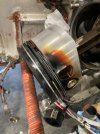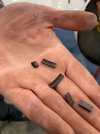Discovered we have 20/80 compression on one cylinder of my Titan x-340 in the lancair. It's blowing past the rings. Cylinder was overhauled just 2 years and about 250 hours ago.
I need to remove it and likely send it back to Gibson's. Would like to know tips, tricks, tools needed, gotchas etc for doing so.
Before anyone says leave it to an a&p, I would but he's gone missing. Really missing, as in the TBI is looking for him.
TBI issues Silver Alert for missing Carter County man | WJHL | Tri-Cities News & Weather
I need to remove it and likely send it back to Gibson's. Would like to know tips, tricks, tools needed, gotchas etc for doing so.
Before anyone says leave it to an a&p, I would but he's gone missing. Really missing, as in the TBI is looking for him.
TBI issues Silver Alert for missing Carter County man | WJHL | Tri-Cities News & Weather















